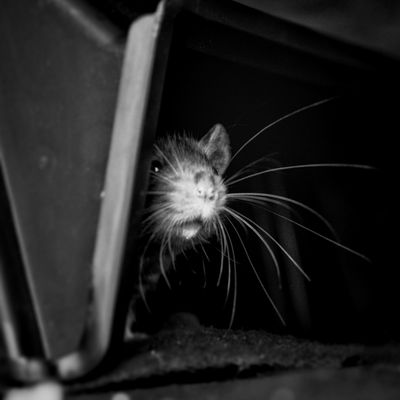
Some people say it takes a decade in New York City to become a real New Yorker, but I think it takes accidentally kicking a rat while going about your daily business. Please clap — I have done this twice. Once, ca. 2018, I suddenly felt a weird pressure on my shoe while walking near the Bedford L, then watched a beefy boy go arching through the air in front of me. The second occasion happened mere weeks ago in the middle of the day. I took my eyes off the ground for one goddamned minute, and immediately my foot made contact with something unsettlingly solid and conspicuously alive — a sensation like tripping over my cat, if he were smaller and more dense. In case you want to write this off as just a gross, weird thing I do, please know that if you stay here long enough, it will happen to you, too. A friend visiting from Los Angeles recently texted to say, “A rat just ran into my shoe.” Mercifully she was wearing massive platform Crocs and above-the-ankle socks when the incident occurred, and you sort of have to be these days, because apparently it’s no longer possible to swing your foot without hitting a rat.
Rats have always been prominent members of New York society. An 1865 New York Times article complains of the city’s “unenviable notoriety” for rats, which even then were growing so “audacious” they would venture out to scrounge food and menace small dogs in broad daylight. In 2022, the situation has grown exponentially worse. The rats are still bullying household pets, but they are also engaging in cannibalism. They are attacking and murdering their brethren, the pigeons. They are hospitalizing (and occasionally killing) people with their urine and continue to assault public-housing complexes across the five boroughs. They are on the train, in the walls, and always underfoot. Since the pandemic began, each successive year has charted record rat numbers. By the end of July, 311 had fielded about 16,000 rat-related reports.
But even the most shocking estimates vastly undersell the scale of the current infestation (after all, those figures represent only the rats that people took the time to call into the city about). Some arresting anecdotal evidence: On a recent trip to the pet store, I counted three crushed rats on the six-minute walk back to my apartment. The other night, I saw a kitten-size rat outside my building thirstily lapping rainwater from a pothole in the moonlight. Last month, I jangled my keys at a small clump of rats that were blocking the sidewalk to gnaw on some bones; suddenly their ranks swelled to about 20, squealing down the pavement in front of me. A trash bag that moved on its own used to be a relatively rare local attraction, but now I encounter roiling garbage heaps whenever I stay out past dusk. Summer is perennially prime time for rats, but oh my God, when did they get so brazen, and why are they so big?
The current siege owes partly to the unique talents of Norway rats, the species that makes up the majority of New York’s murine population. They live for only about a year but accomplish a lot during that time: According to the extermination company Orkin, females can birth between three and 12 litters of up to 22 pups each. Even though they can grow to about 16 inches nose to tail, they can squeeze through half-inch gaps and will happily do so if they catch even a whisper of food. Speaking of, rats don’t actually need that much; about an ounce per day will sustain them. They can chew through most materials, including cinder block, and according to one troubling Google search I did while trying to determine if the rodent nest inside my radiator was full of mouse or rat babies, they can leap about three feet vertically and four feet horizontally. Plus they can survive falls of 50 feet and climb basically any kind of wall, so if I were to vault one from the roof of my five-story apartment building, it would (per Google) “probably” just come back and “try again.” If Fortune favors the bold, then she favors rats above all.
Even knowing all this, pest experts forecast that the pandemic might finally deal the knockout blow, and the rats did initially struggle when their reliable restaurant food sources dried up. But as was the case with Hercules, the journey through hell only made them stronger: Scarcity forced them to fight for survival over dwindling scraps, and it also acclimated them to daytime foraging. Thanks to Sanitation Department cuts, trash collection occurred on an even more sporadic basis than it usually does, leaving a smorgasbord of garbage piled on curbs for days. The role waste plays in this mess really cannot be overstated. During 2019’s government shutdown, PBS NewsHour warned of rodent-fueled pandemonium in D.C.: “Given an all-you-can-eat trash buffet, rats build up strength reserves and produce larger, healthier litters. More food means more rats, potentially for years to come.”
As the city emerged from lockdown, a period of picnic mania saw people spread their trash to parks, longtime strongholds for rats. Then came the era of dining sheds, which helped restaurants stay afloat through COVID and which rats immediately invaded. Some of the more adventurous rodents found new homes inside all those cars New Yorkers acquired in a bid for freedom during the spring and summer of 2020. If you are parking your otherwise serviceable vehicle on city streets and the “CHECK ENGINE” light goes on, understand that the subtext is “for rats.” One car owner told the Times that their mechanic found “chicken bones, some bread, and part of a bacon, egg and cheese sandwich sitting” under the hood of their car, an ideal rat hotel because of all its small warm crevices not easily accessed by humans. “I see new cars, old cars, everyone is coming in now with these rat problems,” Ozzy Dayan, a Hell’s Kitchen mechanic, recently told the Times. “It brings me a lot of business but it’s disgusting.”
When we acquired an infamous rat freak as our mayor, I thought the city might finally mitigate the unholy mélange of special circumstances that allows rodents to flourish. During his time as Brooklyn borough president, Eric Adams developed an obsession with liquefying rats into an evil soup, an attitude that boded well for the war ahead. These days, though, Adams seems more interested in harassing the homeless and bulldozing dirt bikes rather than moving on to the very clear solution to the rat crisis: just putting the curbside trash in big, closed verminproof bins. The Adams administration is slowly rolling out some pilot containers this year — but not with anything approaching the appropriate haste and seemingly not in the areas of greatest need. For now, the most proactive approach comes from the Health Department, which has launched a Rat Academy to help educate concerned citizens and supers about the enemy. Two of the course’s main takeaways, according to Hell Gate: “The only way to get rid of rats is to starve them,” and until we do that, “we will always be playing defense.”
To me, that sounds like another way of saying “we’ve given up” — that the rats have already won and whatever steps municipal authorities take now will focus more on coexistence than eradication or even management. I don’t like this strategy (even indirect contact with rats, just breathing in their dust, can translate to a suite of viruses and hemorrhagic fevers), but I also don’t have a better one; they’re simply too adaptive. If you catch and kill 100 rats one day, you can count on their ranks to be replenished three times over the next. If you harangue your landlord into plugging all the holes in your building, the rats can still scramble up the façade and you’ll still have to go outside eventually. New York is a city made of rats, by rats, for rats — love it or leave it, baby. They will continue to thrive as man-made waste destroys the planet, and not just because they love eating man-made waste: Warming winters mean longer mating seasons mean even more rats. Even when the climate crisis sinks swaths of the city into its surrounding rivers (drowning its human residents in water contaminated by rodent urine), I bet the rats will be okay. Rats can swim. Of course they can.


